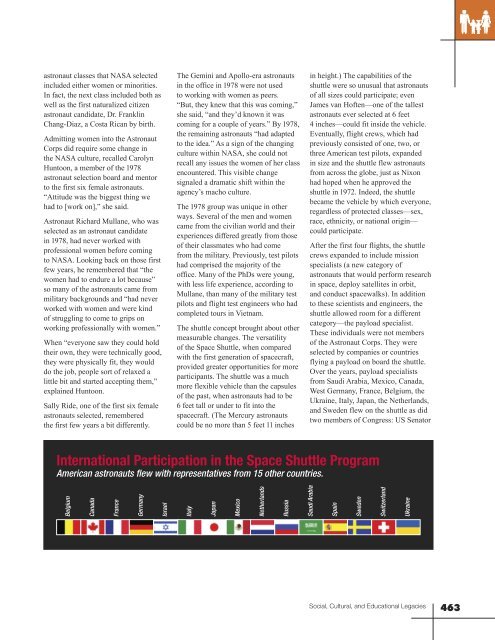Social, Cultural and Educational Legacies - ER - NASA
Social, Cultural and Educational Legacies - ER - NASA
Social, Cultural and Educational Legacies - ER - NASA
Create successful ePaper yourself
Turn your PDF publications into a flip-book with our unique Google optimized e-Paper software.
astronaut classes that <strong>NASA</strong> selectedincluded either women or minorities.In fact, the next class included both aswell as the first naturalized citizenastronaut c<strong>and</strong>idate, Dr. FranklinChang-Diaz, a Costa Rican by birth.Admitting women into the AstronautCorps did require some change inthe <strong>NASA</strong> culture, recalled CarolynHuntoon, a member of the 1978astronaut selection board <strong>and</strong> mentorto the first six female astronauts.“Attitude was the biggest thing wehad to [work on],” she said.Astronaut Richard Mullane, who wasselected as an astronaut c<strong>and</strong>idatein 1978, had never worked withprofessional women before comingto <strong>NASA</strong>. Looking back on those firstfew years, he remembered that “thewomen had to endure a lot because”so many of the astronauts came frommilitary backgrounds <strong>and</strong> “had neverworked with women <strong>and</strong> were kindof struggling to come to grips onworking professionally with women.”When “everyone saw they could holdtheir own, they were technically good,they were physically fit, they woulddo the job, people sort of relaxed alittle bit <strong>and</strong> started accepting them,”explained Huntoon.Sally Ride, one of the first six femaleastronauts selected, rememberedthe first few years a bit differently.The Gemini <strong>and</strong> Apollo-era astronautsin the office in 1978 were not usedto working with women as peers.“But, they knew that this was coming,”she said, “<strong>and</strong> they’d known it wascoming for a couple of years.” By 1978,the remaining astronauts “had adaptedto the idea.” As a sign of the changingculture within <strong>NASA</strong>, she could notrecall any issues the women of her classencountered. This visible changesignaled a dramatic shift within theagency’s macho culture.The 1978 group was unique in otherways. Several of the men <strong>and</strong> womencame from the civilian world <strong>and</strong> theirexperiences differed greatly from thoseof their classmates who had comefrom the military. Previously, test pilotshad comprised the majority of theoffice. Many of the PhDs were young,with less life experience, according toMullane, than many of the military testpilots <strong>and</strong> flight test engineers who hadcompleted tours in Vietnam.The shuttle concept brought about othermeasurable changes. The versatilityof the Space Shuttle, when comparedwith the first generation of spacecraft,provided greater opportunities for moreparticipants. The shuttle was a muchmore flexible vehicle than the capsulesof the past, when astronauts had to be6 feet tall or under to fit into thespacecraft. (The Mercury astronautscould be no more than 5 feet 11 inchesin height.) The capabilities of theshuttle were so unusual that astronautsof all sizes could participate; evenJames van Hoften—one of the tallestastronauts ever selected at 6 feet4 inches—could fit inside the vehicle.Eventually, flight crews, which hadpreviously consisted of one, two, orthree American test pilots, exp<strong>and</strong>edin size <strong>and</strong> the shuttle flew astronautsfrom across the globe, just as Nixonhad hoped when he approved theshuttle in 1972. Indeed, the shuttlebecame the vehicle by which everyone,regardless of protected classes—sex,race, ethnicity, or national origin—could participate.After the first four flights, the shuttlecrews exp<strong>and</strong>ed to include missionspecialists (a new category ofastronauts that would perform researchin space, deploy satellites in orbit,<strong>and</strong> conduct spacewalks). In additionto these scientists <strong>and</strong> engineers, theshuttle allowed room for a differentcategory—the payload specialist.These individuals were not membersof the Astronaut Corps. They wereselected by companies or countriesflying a payload on board the shuttle.Over the years, payload specialistsfrom Saudi Arabia, Mexico, Canada,West Germany, France, Belgium, theUkraine, Italy, Japan, the Netherl<strong>and</strong>s,<strong>and</strong> Sweden flew on the shuttle as didtwo members of Congress: US SenatorInternational Participation in the Space Shuttle ProgramAmerican astronauts flew with representatives from 15 other countries.BelgiumCanadaFranceGermanyIsraelItalyJapanMexicoNetherl<strong>and</strong>sRussiaSaudi ArabiaSpainSwedenSwitzerl<strong>and</strong>Ukraine<strong>Social</strong>, <strong>Cultural</strong>, <strong>and</strong> <strong>Educational</strong> <strong>Legacies</strong>463
















